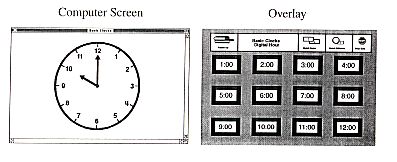
By Erin DeHaven
SUBJECT AREA: Telling Time and Awareness of Time
PUBLISHER: IntelliTools
(800)899-6687
COST: $49.95; Multi-user price: $35 for 25+ users
INTENDED AUDIENCE: Students in Grade 1 or higher
NOTABLE SYSTEM REQUIREMENTS: Macintosh: System 6.07 or higher; 2 MB RAM; IntelliKeys

MATERIALS: Learning to Tell Time comes with 10 custom overlays for IntelliKeys and follow-up activity sheets that can be printed out to reinforce newly learned concepts.
EDUCATIONAL GOALS: ExploringTime: To learn the concepts of a.m. and p.m.; to relate a.m./p.m. to individual hours, including the terms midnight and noon; to estimate the time of day that everyday events might occur.
Learning to Read Clocks: To match the time to the hour on both digital and analog clocks; to match the time to the half hour on both digital and analog clocks; and to understand the difference between the minute hand and the hour hand.
DESCRIPTION: These two programs provide drill and practice on functional time telling. Exploring Time reinforces the skills necessary to estimate the time of day and associate activities that occur either in the a.m. or p.m. For example, using speech output, the program asks, "About what time do you eat breakfast?" Students then select a clock face on the IntelliKeys overlay. Students are also given scenarios about events that occur either in the morning or in the evening and are asked, "Is the time a.m. or p.m.?" If they answer incorrectly, they are told, "Oops, try again" and are given clues to help them find the correct answer.
Telling Time offers the option of learning on analog and/or digital clocks. Its purpose is to not only introduce the clock reading skill, but to give students an understanding that although two clocks may look completely different, they both tell the same time. There are a number of different types of "quizzes" that students can work on, including telling time on the hour and half hour on both digital and analog faced clocks.
STRENGTHS: These programs address a very real need for students with learning difficulties and/or mental retardation. They provide much needed practice in time telling without requiring any reading or writing. The screen displays and overlays are uncluttered, and the untimed nature of questions makes the programs appropriate for students who need extra time to think. Both programs are easy to use and provide follow up off-computer activities to reinforce newly learned concepts. Teachers can individualize the quizzes by making up their own activities and scenarios. Providing clues following wrong answers is a helpful feature.
WEAKNESSES: The overlays in Telling Time may seem overcrowded to some students. A child who is not familiar with the sequential order of time may have a hard time finding the clock face that he or she is looking for.
SUMMARY: Learning to Tell Time is a valuable software package for students who need help in this life skill area. The use of custom overlays for IntelliKeys makes the program accessible to nonreaders and people who have difficulty writing or completing worksheets. The Exploring Time component is an interesting approach to teaching simple time concepts to students who are not yet able to learn to read clocks. These programs provide excellent IntelliKeys-based programs for teachers and parents who do not have the time to create their own custom programs and overlays with IntelliPics.
Erin DeHaven is a graduate student in the Department of Special Education at The College of New Jersey.
